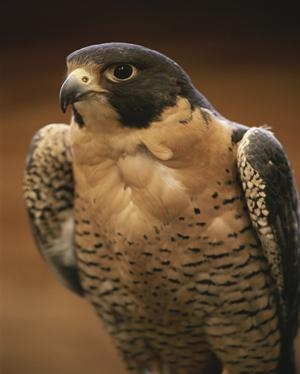Mon, Sep 10, 2012
These Fighting Falcons Are Not F-16s
The 22nd Air Refueling Wing Bird Aircraft Strike Hazard program is being overhauled with new contractors employing the use of a falcon to keep skies clear from avian adversaries. The BASH program is in place to reduce bird strikes by introducing a natural predator into the area to ward off smaller animals. McConnell Air Force Base in Kansas will be changing the type of predator used from a dog to a pair of falcons.

Elaina, a Barbary falcon, and Jack, a Peregrine-Prairie hybrid (similar bird pictured), will be McConnell's new solution, capable of providing smaller birds the motivation to move along. "One strike, if the bird hits the wrong spot on a plane, could do fifty to one hundred thousand dollars worth of damage," said Maj. Jeremy Fischman, 22nd ARW flight safety chief. "It is really easy for the program to pay for itself by preventing one bad bird strike."
Preventing bird strikes also maintains safety by not putting Airmen in a situation where they have to maneuver aircraft damaged in flight. There were 4,471 bird strikes Air Force-wide in 2011, costing the service $13,061,140.
While the fields and ponds surrounding McConnell are inviting habitats for birds, the falcons will be introduced as a predatory species. The birds instinctively know that it is too dangerous to seek food and shelter once they note the presence of the falcons. There are several other ways that bird and wildlife populations are humanely controlled around the airfield including fencing certain areas off, mowing the grass near the flight line to a prescribed height and draining puddles. Cannon blasts and noise makers can also be used to disperse unwanted flocks. "I'll be trapping or using depredation to manage problem mammals," said Elizabeth Hensel, Falcon Environmental Services, Inc. wildlife manager.
For example, if there is a red-tail hawk, Hensel can trap the bird and move it to another location 50 miles away leading to one less bird threatening the fleet. Having falcons will help disperse the birds and hopefully there will be less of a bird strike concern for the KC-135 Stratotankers, said Hensel.
(USAF Image)
ANN salutes Airman 1st Class Jose L. Leon 22nd Air Refueling Wing Public Affairs.
More News
A Puff Of Smoke Came Out From The Top Of The Engine Cowling Followed By A Total Loss Of Engine Power On May 9, 2025, about 1020 mountain daylight time, an experimental amateur-buil>[...]
From 2022 (YouTube Edition): Jenny, I’ve Got Your Number... Among the magnificent antique aircraft on display at EAA’s AirVenture 2022 was a 1918 Curtiss Jenny painstak>[...]
Very High Frequency (VHF) The frequency band between 30 and 300 MHz. Portions of this band, 108 to 118 MHz, are used for certain NAVAIDs; 118 to 136 MHz are used for civil air/grou>[...]
“From approximately November 2021 through January 2022, Britton-Harr, acting on behalf of AeroVanti, entered into lease-purchase agreements for five Piaggio-manufactured airc>[...]
Microburst A small downburst with outbursts of damaging winds extending 2.5 miles or less. In spite of its small horizontal scale, an intense microburst could induce wind speeds as>[...]
 NTSB Prelim: Lee Aviation LLC JA30 SuperStol
NTSB Prelim: Lee Aviation LLC JA30 SuperStol Classic Aero-TV: Curtiss Jenny Build Wows AirVenture Crowds
Classic Aero-TV: Curtiss Jenny Build Wows AirVenture Crowds ANN's Daily Aero-Term (05.30.25): Very High Frequency (VHF)
ANN's Daily Aero-Term (05.30.25): Very High Frequency (VHF) Aero-News: Quote of the Day (05.30.25)
Aero-News: Quote of the Day (05.30.25) ANN's Daily Aero-Term (05.31.25): Microburst
ANN's Daily Aero-Term (05.31.25): Microburst



